Contrary to popular perception, the United States (US)-Soviet rivalry was not just a militarised contest with its spheres of influence, arms race, alliance systems, arms control agreements, tripwire forces in Berlin, and proxy wars in the Third World. Both the superpowers during the Cold War, in their pursuit of demonstrating the superiority of their own economic models, initiated robust domestic welfare programmes as well as generous aid handouts to allies. Further, the US and the erstwhile Soviet Union used economic aid as a tool in the competition for influence in the Third World. The trajectory of the economic Cold War between the two superpowers with universalist ideological visions contains instructive lessons for the current era of great power competition.
Unfolding in the shadow of decolonisation from the mid-1950s onwards, the economic Cold War entailed demonstrating the superiority of their models by bolstering development initiatives in the Third World. On the other hand, the decolonisation imperative for the Third World leaders and officials translated into a striving for rapid economic development while protecting their economic sovereignty. In a paradoxical bind, however, the lack of sufficient state capacity led the Third World officials to rely on external assistance to pursue economic independence. Based on the Indian case study, the development politics in the Cold War era can provide a relevant guidepost for the developing nations to navigate the ongoing Sino-US competition for influence in the Global South.




